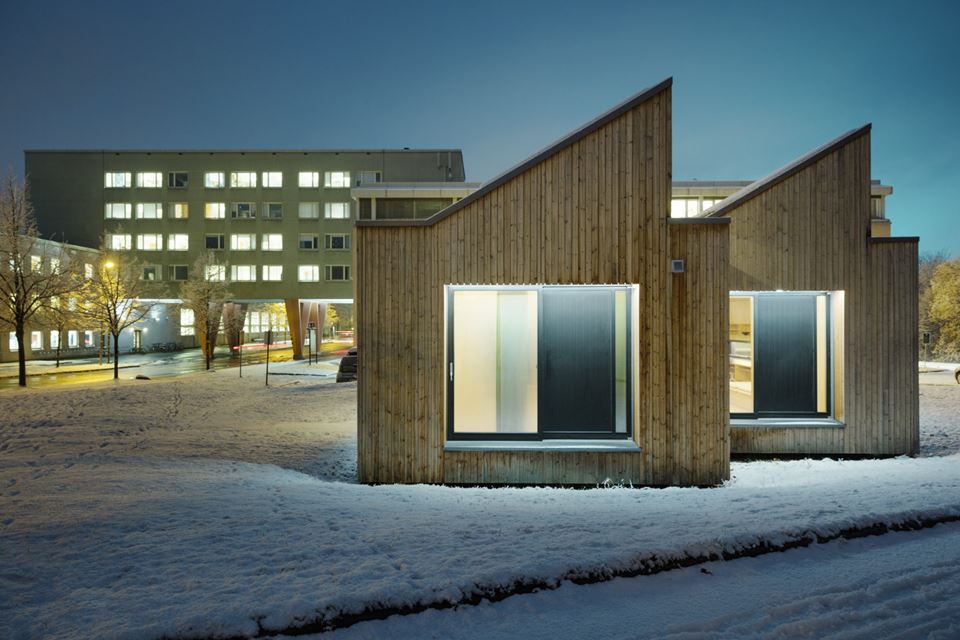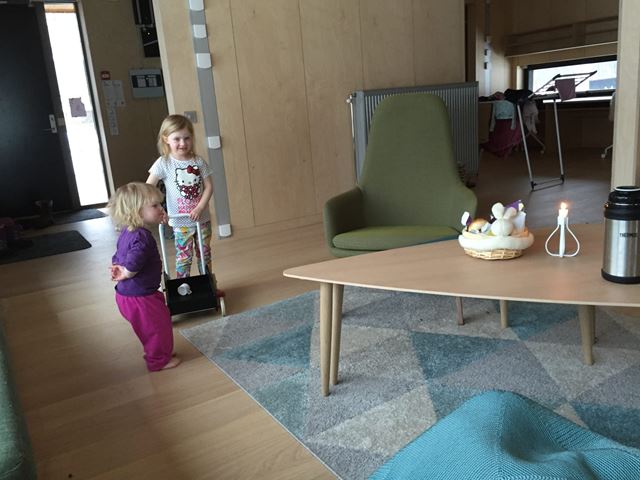
These two sisters were comfortable enough in the experimental house to play barefoot, even when it was cold outside. Photo: Ruth Woods, SINTEF
When SINTEF researcher Ruth Woods thinks about her research on an experimental energy-efficient house built on the NTNU campus, she often thinks of a single photograph.
It shows two young sisters who lived in the house for a time. The girls are standing at the edge of a carpet, barefoot on a wooden floor. The older girl, who is three, is wearing a Hello Kitty tee shirt. Her two-year-old sister is clad in a purple shirt with the sleeves rolled up.
“It’s just an ordinary picture of two little girls playing, but it tells me a lot about the house,” Woods said. “They are playing barefoot, but it was cold outside. They could have been in a normal house, but they would have had to be wearing a lot more clothing.”
But this was no normal house. And despite the chill outside, the girls were cozy and warm. Warm enough, in fact, to go barefoot.
Adjusting to technology
The energy efficient house, called the “ZEB Living Lab”, was part of a larger research centre called ZEB, the Research Centre on Zero Emission Buildings. The centre, funded by the Research Council of Norway and 25 industry and government partners, had as its goal to study buildings with extremely low energy requirements and a net zero climate footprint. It completed its 8-year mission on 1 April this year.
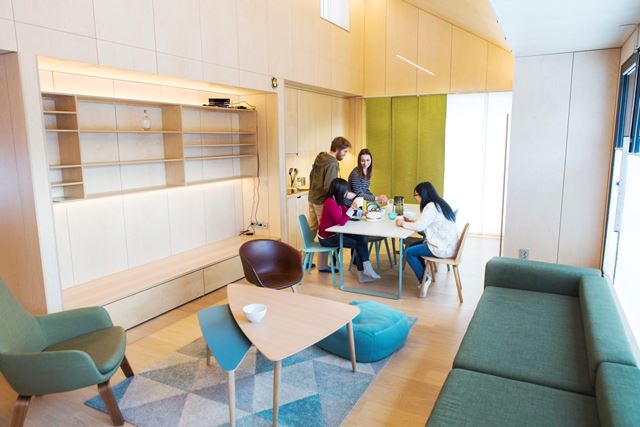
Much of the furniture in the Living Lab was built right into the structure. Photo: Morten Andre Samdal
ZEB also looked at what it will take to get people to work, live in or build in energy efficient housing.
Woods worked with Marius Korsnes, a postdoc at NTNU’s Department of Interdisciplinary Studies of Culture, to answer questions related to that issue: Can a high-tech energy-efficient house really feel like home? How does living in a building where we are enveloped by technology affect us? And how do we, in turn, affect the technology?
To answer these questions, the two researchers enlisted the help of six groups, or 16 people all told. Each group lived in the house for 25 days, starting in October 2015 and running until April 2016.
“We had students, we had families with children, we had elderly people,” Korsnes said. “We tried to pick out different representative groups. It was a user experiment where we tried to find out how people were impacted by living there, and the way in which the house was impacted by people.”
Simple design, high-tech features
The house was designed by architect and NTNU associate professor Luca Finocchiaro as a detached, single-family home, like roughly half of Norwegian housing.
Much of the furniture was built into the structure: a couch, a long workbench along one wall, cupboards and storage in the living room. The beds fold against the wall to make more room in the bedrooms, if needed.
Among other technologies, it has ultra-insulated walls and special material in the ceiling to help prevent the house from overheating in the summer.
There’s a large high-tech layered glass window that can be used to pre-warm air for the heating system, rooftop solar panels, and a combination of heating systems and “balanced ventilation”. The systems are designed to provide the most comfort with the least amount of energy. All of this is watched over by 259 different sensors, placed throughout the house.
Comfort and heat
The technology that was most important for both researchers and residents was the heating system — not surprising for a house at 63 degrees north latitude.
The house had underfloor heating, a radiator and a ventilation system that provided a flow of warm air. Unfortunately, when the one group moved into the house in January 2016, the heating system wasn’t quite working correctly, and the outside temperatures dropped to -14 C.
“The technology chose not to work that week, so the ventilation system was sending too much cold air in,” Woods said. In response, the group, a family of four, took matters into their own hands. They bought a plug-in heater to augment the house’s systems.
“Yes, people adapted to the house,” she said. “But they adapted the house to them. If they needed to make changes, they did that. When it was too cold, they went and got a heater.”
A cultural need for cold nights
For those who don’t live in Norway, it may seem like a strange custom: Norwegians open their bedroom windows at night, even in winter. Perhaps it’s their Viking roots: They like to sleep in the cold, buried under a warm duvet.
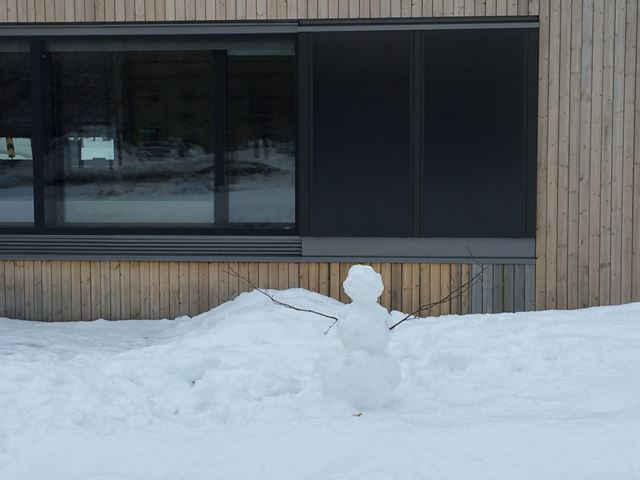
Cold outside, warm inside. The picture shows the special windows in the zero-emission house, which allowed air to be pre-warmed. Photo: Ruth Woods/SINTEF
This posed challenges for the Living Lab, which relies on a delicate balance of airflow and floor heating to hold the house at a steady, comfortable temperature.
Some residents “adapted to the house,” Woods said. “One of the things they did was bring in summer duvets.”
Still others stuck to their old ways.
“The indoor air quality was good, but we had to sleep with open windows at night to get the right bedroom temperature,” said Kristian Angen, who lived in the house with his wife and their two young daughters, the girls in the photograph taken by Woods.
An older couple that lived in the house in March and April and who heated their own home with wood found that they missed the rituals that involved.
“Heating practices, that is where we really noticed deep-seated habits,” Korsnes said. “We saw it with the elderly couple who heated with wood in their own home…they would go out, find the wood, cut it, stack it… It was a pastime as much as anything, and they missed that.”
In general, however, the heating system worked, and “the residents agreed that living in a zero emission house was less technically demanding than they thought it would be,” Woods said. “There is an assumption that it has to be difficult to live in a house that has a balanced ventilation system, a technical ventilation system — but it isn’t.”
Waffle irons, coffee makers and vegetarianism
Woods is an anthropologist, and she was curious to how people made the Living Lab into their own home.
She was surprised that the families with children brought the least with them. But pretty much everyone brought relatively little. Only one group brought a television — there was no TV in the house — and most decoration was limited to photographs and candles, which Norwegians love. Residents also brought waffle irons and coffee makers, which are other reflections of typical Norwegian life.
The researchers were surprised to find that living in the house made people think about what they needed — and didn’t — in their normal, everyday lives. One group even decided to try vegetarianism while they lived in the house.
“One thing every group said was that they realized that their own homes were so full of things they really didn’t need,” Korsnes said. “They started to reflect on their environmental use of things.”
Simple to use, easy to spread
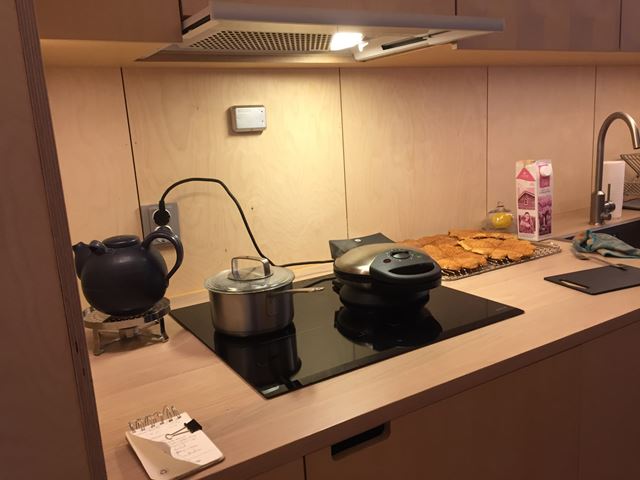
Virtually every Norwegian household has a waffle iron. Many of the people who tested the zero-emission house brought their own. Photo: Ruth Woods/SINTEF
The physicist and futurist Freeman Dyson once wrote: “The technologies which have had the most profound effects on human life are usually simple.”
For Korsnes, simplicity is also key in helping people adopt the new technologies society needs in the fight against global warming.
“Knowing more about these technologies can help us to see to what extent they can spread,” he said. “Basically, what we call an innovation has to do with how technology gets accepted and adapted by more people. That needs to be anchored in normal usage, the everyday life use of a technology.”
“You can’t successfully spread a technology without it being something that people want to use, no matter how good your intentions are about it,” he added.
From that perspective, the ZEB Living Lab did have an impact.
One of the elderly couples liked the high-tech appliances in the kitchen so much that they scrapped their old ones and bought the kind they used in the Living Lab, Woods said.
And for resident Kristian Angen, the experience of living in the house may have changed his future housing decisions.
“We thought it was absolutely top to live in the house. In our opinion, the ZEB house is as comfortable as a traditional house, if not better,” he said. “We could have gladly continued to live there. In any event, we will consider the technology if we are ever going to build a new home.”
